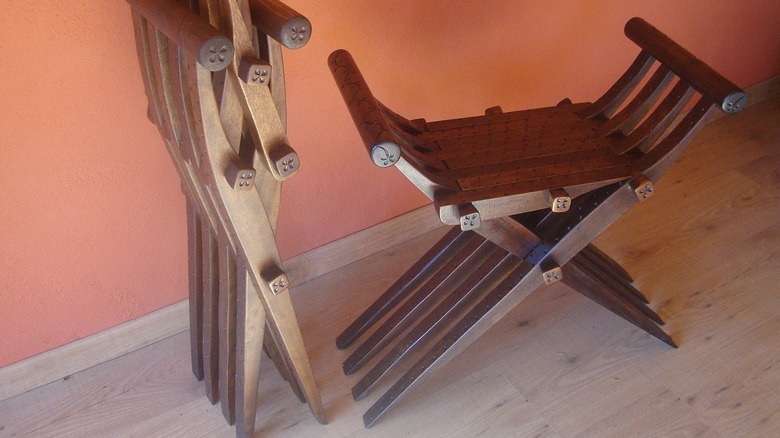Who Invented The Folding Chair? The Answer Is More Complicated Than You Think
The history of the folding chair might not sound like the most exciting subject, but there is a lot more behind this invention than you would probably expect. If you do a quick Google search on the topic, you'll get a straightforward answer: the folding chair was invented in 1911 by Nathaniel Alexander, but this isn't quite accurate.
Alexander did secure an early patent for a folding chair (more on this later), but looking further back in time reveals that he was not the first person to hit on the idea of a convenient collapsible chair. Folding chairs have been found at historical sites dating back to ancient times, but they used to hold a different sort of significance. Rather than serving as a practical, everyman item to whip out for the school assembly, the folding chair was once seen as a symbol of lofty societal status, even worthy of a king.
Folding chairs from ancient times
Ancient Egyptians were consistently at the forefront of technology, from advanced farming tools to developing a process to turn papyrus into paper. It seems they were also at the forefront of comfort, creating some of the earliest predecessors of folding chairs that have ever been discovered. The most notable example is a folding stool that was found in the tomb of Tutankhamun (King Tut), who died circa 1324 B.C. The legs of the stool, which are carved to look like duck heads, are joined in the center by a hinge, just like modern folding chairs. However, the seat of the chair was made of wood, meaning it couldn't actually fold up, and was probably made with decorative purposes in mind.
There is another stool dating back to the same era that actually could fold up. A Bronze Age site in Guldhøj, Denmark yielded the discovery of a small folding stool with hinged legs mirroring both modern folding chairs and the artifact found in King Tut's tomb. Unlike the latter, however, the Guldhøj stool had a seat made from otter skin, a fragment of which was found still attached to the furniture. This would have allowed the stool to fold up for easy storage and transport. Based on the fact that these early folding chairs were recovered from gravesites alongside other riches, and appear to have been very rare in their time, historians believe they were a symbol of wealth and high social status.
Folding chairs of the Middle Ages
The medieval period marked significant developments in folding furniture. Over 20 European gravesites from the Early Middle Ages have been found to contain folding chairs. Once such site, uncovered in the German state of Bavaria, contained a folding chair with a frame made of iron. The grave site was dated back to approximately A.D. 600, a time when metal furniture was exceptionally rare, and would have only been used by people of high social status and wealth. This idea is supported by the fact that the Bavarian gravesite contained several pieces of jewelry, including a pearl necklace around the skeleton's neck.
Although the medieval period is often seen as a time of technological stagnation between the fall of the Roman Empire and the dawn of the Renaissance, the era actually did bring a number of important developments. The principles of modern science were starting to be laid down as the High Middle Ages came to a close, and greater ambitions in the fields of engineering and design made items like folding chairs far more common. A notable example is the faldstool, a type of folding stool that became widely used in the Roman Catholic Church around the 12th century. Bishops, who typically officiated from a throne in their cathedral, began using faldstools as a convenient way to give sermons on the go. Faldstools were specifically designed without a back so that they could serve a double purpose. The bishop could sit on it to officiate, or kneel on it to pray.
The first modern folding chairs
It is impossible to say who invented the very first folding chair, since the earliest examples come from a time before patents existed. The first documented patent for a folding chair was issued in 1855 to John Cram of Boston, Massachusetts. However, in Cram's patent filing, he acknowledges, "I do not lay claim to the broad ground of making a chair so that its parts may fold." In the same filing, he also acknowledges a similar patent application from an individual identified only as "J. Middleton," however, no records of Middleton's invention exist.
The inventor most associated with the folding chair is the aforementioned Nathaniel Alexander, a Black American from Lynchburg, Virginia who patented his own version in 1911. Little is known of Alexander's background, but a clue may lie in the patent application itself. One of the witnesses listed is James R. L. Diggs. Diggs was a Baptist minister who served as president of the Virginia Theological Seminary and College in Lynchburg at the time of Alexander's patent filing. He was also one of the founders of the Niagara Movement, which evolved into the modern NAACP.
The exact nature of Diggs and Alexander's relationship is unknown, but the design of Alexander's chair certainly implies he had a connection to the church. What made Alexander's chair unique was the fact that it incorporated a book rest that folded out from the back, allowing the person seated behind the chair to prop a Bible or prayer book up in front of them.



